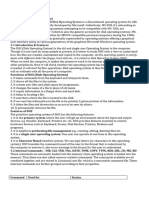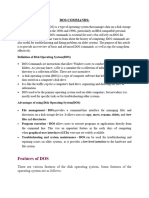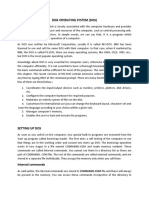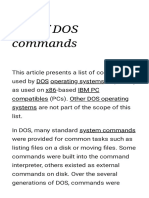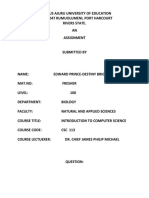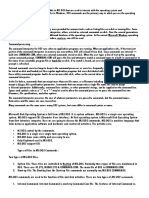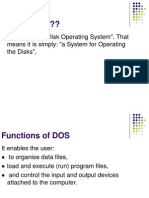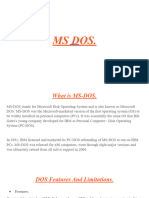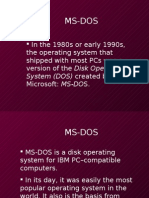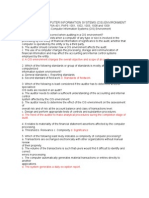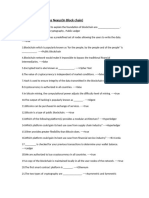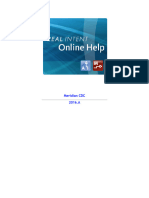DISK OPERATING SYSTEM
What is a disk operating system?
A DOS, or disk operating system, is an operating system that runs from a disk drive.
How does a disk operating system work?
When a computer is powered on it goes through various steps called the boot process. For a computer running a
disk operating system, the following six steps are standard:
1. The read-only memory (ROM) bootstrap loader reads the Master Boot Record and passes control over to it.
2. The boot record loads the disk operating system into memory, and it takes control of the machine.
3. The computer transfers data stored on a magnetic disk to its main memory, the random access memory.
4. It also transfers data to external devices attached to the computer, such as a computer screen or printer.
5. The computer provides various application programming interfaces for programs like character input/output
(I/O), memory management, program loading and termination, as well as handling input from the user
through a keyboard.
6. The OS also provides file management that organizes, reads and writes files on storage. The files are
organized in a hierarchical structure of directories, subdirectories and files.
A disk operating system doesn't have a graphical user interface (GUI). Its interface is character-based, so users
must type commands in the command line to indicate what actions they want.
DOS features
Command-line interface (CLI). It does not have a GUI and doesn't accept mouse inputs. It is a character-
based interface system where all commands are entered in text at the command-line prompt.
Management. A disk operating system can manage a computer's files, I/O system and its memory.
Limitations
No built-in security. It does not have built-in security, such as file ownership and permissions.
No multiusers or multitasking. It also does not support multiusers or multitasking. It is only able to run
one program at a time, but it provides direct access to the basic I/O system and underlying hardware.
HISTORY
American computer programmer Timothy Paterson, a developer for TIM PATERSON
Seattle Computer Products (microcomputer hardware company), wrote
the original operating system for the Intel Corporation's 8086 INVENTOR OF DOS
microprocessor in 1980, initially calling it QDOS (Quick and Dirty
Operating System), which was soon renamed 86-DOS.
But here's what Gates did: he bought a program from a small software
company called the Quick and Dirty Operating System (or Q-DOS), for
the price of 75,000$.
He then changed its name to MS-DOS (Microsoft DOS) .Gates reached
out to Paterson and purchased 86-DOS from him, allegedly for $50,000.
Microsoft turned it into Microsoft Disk Operating System, or MS-DOS,
which they introduced on this day in 1981. Within a year Microsoft
� licensed MS-DOS to over 70 other companies, which supplied the operating system for their own hardware,
sometimes under their own names.
DOS Versions:
86-Dos 0.10 (August 1980)
The original author of this version was Tim Paterson and it was the first owned by Seattle Computer Products
(SCP).
PC DOS 1.0 (August 1981)
Microsoft developed it and was the first IBM release for its personal computers.
PC DOS 1.1 (May 1982)
PC DOS 2.0 (March 1983)
PC DOS 2.1 (November 1983)
PC DOS 3.0 (August 1984)
PC DOS 3.1 (April 1985)
PC DOS 3.2 (March 1986)
PC DOS 3.3 (April 1987)
MS-DOS 3.31 (November 1987)
DR DOS 3.31 (May 1988)
IBM DOS 4.0 (July 1988)
DR DOS 5.0 (April 1990)
MS-DOS 5.0 (June 1991)
DR DOS 6.0 (September 1991)
MS-DOS 6.0 (March 1993)
PC DOS 6.1 (June 1993)
MS-DOS 6.2 (September 1993)
PC DOS 6.3 (April 1994)
MS-DOS 6.22 (June 1994)
PC DOS 7.0 (April 1995)
The release of Windows 3.0 in 1990 had the GUI operating system, which was user-friendly than the command
line used by DOS. Further release of the Windows 9X saw most users reject DOS as it could run its system
operations independently. In 1994, Microsoft released their last MS-DOS and announced their split with DOS a
few months later. This marked the end of the disk operating system as its final release was on September 14,
2000. The GUI operating system supported in Windows took over the market and has become the most popular
operating system.
Common DOS commands
MS-DOS is not case-sensitive, so commands can be typed in either uppercase or lowercase. However, other
disk operating systems have case-sensitive CLIs. DOS commands include the following.
DOS Internal Commands
DATE: This command is used to display the system’s Syntax: C:\> DATE
date and also allows to set new data.
TIME: This command is used to display the current Syntax: C:\> TIME
system time and also allows to change time.
CLS: This command is used to clear the screen Syntax: C:\> CLS
� COPY CON: This command is used to create a new text file in Syntax: C:\> COPY CON
MS DOS. readersnepal.txt
TYPE: This command is used to display the content of Syntax: C:\> TYPE
text file. readersnepal.txt
REN or This Command is used to rename a file. Syntax: C:\> REN readersnepal.txt
RENAME: readersnp.txt
DEL or ERASE: This command is used to delete the specified file. Syntax: C:\> DEL readersnp.txt
COPY: This command is used to copy a file from one Syntax: C:\> COPY readersnp.txt
location to another. D:\web
MOVE: This command is used to move file from one Syntax: C:\> MOVE readersnp.txt
location to another. D:\web
[Note: Using COPY files remains in both source and destination but using MOVE file remains only on
destination]
MD or MKDIR: MD means Make Directory. It allows us to create Syntax: C:\> MD readers
a directory in the specified location.
CD or CHDIR: CD means Change Directory. It allows us to open Syntax: C:\> CD readers
or exit from any directory.
RD or RMDIR: RD means Remove Directory. It allows us to Syntax: C:\> RD readers
delete on empty directory.
DIR: This command is used to display the list of files Syntax: C:\> DIR
and directories.
This will display all the files and directories from C:\> DIR /S
sub directories as well
This will display all the files having EXE C:\> DIR *.EXE
extension. Here, * is a wildcard
VER: This command displays the current MD DOS Syntax: C:\>VER
version number.
VOL: This command shows the disk volume label and Syntax: C:\> VOL A:
serial number
DOS External Command
a) ATTRIB: This command is used to set or remove the file attributes.
Syntax: ATTRIB [ ] [drive:] [path] [filename] [/s]
The empty [ ] can be filled with + to Set and + to Remove followed by R, A, S, H depending upon
requirements.
Example: C:\> ATTRIB +H D:\*.jpg
This will hide all the file with .jpg extension i.e. images from D: drive.
b) EDIT: This command is used to create a text file in MS DOS. It allows us to edit, save and print the text files.
Syntax: EDIT readersnepal.txt
�It displays the contents of the file readersnepal.txt, if the file doesn’t exist it creates a new file with that name.
c) CHKDSK: This command check the disk status and shows the status report including total disk space, free
disk space and so on.
Syntax: C:\> CHKDSK
d) FORMAT: This command is used to format a disk.
Syntax: C:\> FORMAT D:
This will format D: drive
e) TREE: This command is used to display the tree structure of a drive or path graphically.
Syntax: C:\> TREE
It will display all the structure of directory or C: drive
f) SYS: This command is used to create a bootable disk by copying system file onto it.
Syntax: C:\> SYS D:
This will copy system files from C: drive to D: drive to make D: drive bootable.
C:\> SYS D: E:
This will copy system files from D: drive to E: drive to make E: drive bootable.
g) LABEL: This command is used to display and set the volume table of a disk i.e. name for the disk drive.
Syntax: D:\> LABEL
This will allow us to enter the volume label of D: drive.
h) SCANDISK: This command is used to scan the disk, check the status of disk and fixes errors if any and gives
the detail reports of the disk drive.
Syntax: C:\> SCANDISK
i) XCOPY: This command is used to copy one or more directories including files and sub-directories from one
location to another.
Syntax: C:\> XCOPY D:/S E:/V
This command copies all the directories including sub directories of D: drive to E: drive and verifies after
copying the files.
Here, /S copies all sources directories and sub directories that are not empty
/V verifies each files as it is written to the destination file.
FAQ
When did DOS come out?
DOS was released on August 12, 1981.
Who wrote the original disk operating system?
The original author of DOS was TIM Peterson (born June 1, 1956), who worked as a Technician at a Seattle
company.
What was the first DOS?
QDOS (quick and dirty operating system) was the first DOS, later renamed 86-DOS.
What was the original price of DOS?
PC-DOS was the first released DOS version to the public and was sold at $40.
What happened to DOS?
Users rejected DOS after the development of the GUI operating system, which was user-friendly compared to
the Character-based User Interface used by DOS.










